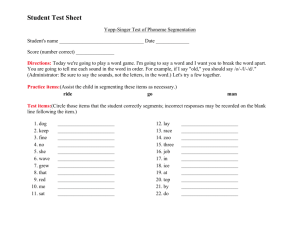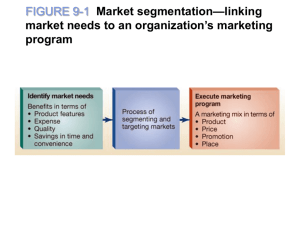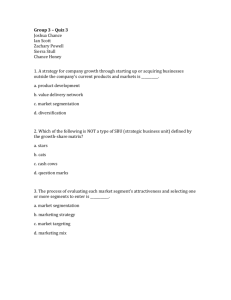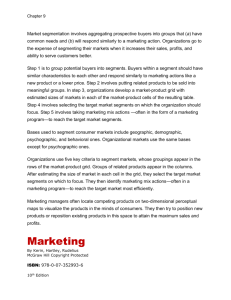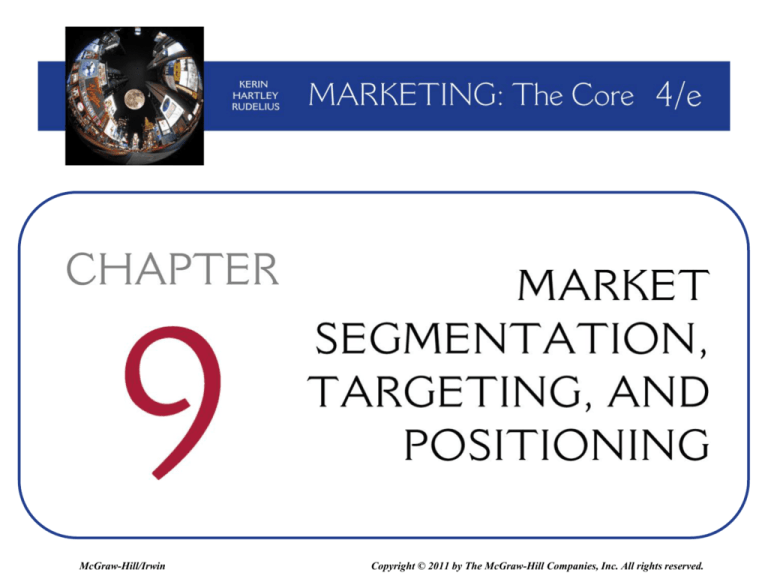
McGraw-Hill/Irwin
Copyright © 2011 by The McGraw-Hill Companies, Inc. All rights reserved.
LEARNING OBJECTIVES (LO)
AFTER READING CHAPTER 9, YOU SHOULD BE ABLE TO:
LO1
Explain what market segmentation is
and when to use it.
LO2
Identify the five steps involved in
segmenting and targeting markets.
LO3
Recognize the bases used to segment
consumer and organizational markets.
9-2
LEARNING OBJECTIVES (LO)
AFTER READING CHAPTER 9, YOU SHOULD BE ABLE TO:
LO4
Develop a market-product grid
to identify a target market and
recommend resulting actions.
LO5
Explain how marketing managers
position products in the marketplace.
9-3
ZAPPOS.COM: DELIVERING “WOW” THROUGH
MARKET SEGMENTATION AND SERVICE
A Clear Market
Segmentation
Strategy
Delivering WOW
Customer Service
9-4
LO1
WHY SEGMENT MARKETS?
WHAT MARKET SEGMENTATION MEANS
Market Segmentation
Market Segments
Product Differentiation
Segmentation: Linking Needs to Actions
The Zappos Segmentation Strategy
9-5
FIGURE 9-1 Market segmentation links
market needs to an organization’s marketing
program through marketing mix actions
9-6
LO1
WHY SEGMENT MARKETS?
WHEN AND HOW TO SEGMENT MARKETS
One-Size-Fits-All Mass Markets
No Longer Exist
One Product and
Multiple Market Segments
Multiple Products and
Multiple Market Segments
• “Tiffany/Walmart” Strategies
9-7
LO1
Sporting News Baseball Yearbook
What market segmentation strategy is used?
9-8
LO1
Harry Potter
What market segmentation strategy is used?
9-9
LO1
Ann Taylor and Ann Taylor Loft
What is the danger of a two-segment strategy?
9-10
LO1
WHY SEGMENT MARKETS?
WHEN AND HOW TO SEGMENT MARKETS
Segments of One: Mass Customization
• Mass Customization
• Build-to-Order (BTO)
9-11
LO1
WHY SEGMENT MARKETS?
WHEN AND HOW TO SEGMENT MARKETS
The Segmentation Tradeoff:
Synergies vs. Cannibalization
• Organizational Synergy
• Customer Value
• Cannibalization
9-12
FIGURE 9-2 The five key steps in
segmenting and targeting markets that link
market needs to a firm’s marketing program
9-13
LO2
STEPS IN SEGMENTING AND TARGETING MARKETS
STEP 1: GROUP POTENTIAL BUYERS INTO SEGMENTS
Criteria to Use in Forming the Segments
• Simplicity and Cost-Effectiveness of Assigning
Potential Buyers to Segments
• Potential for Increased Profit
• Similarity of Needs of Potential Buyers
Within a Segment
• Difference of Needs of Buyers Among Segments
• Potential of a Marketing Action to Reach
a Segment
9-14
LO3
STEPS IN SEGMENTING AND TARGETING MARKETS
STEP 1: GROUP POTENTIAL BUYERS INTO SEGMENTS
Ways to Segment Consumer Markets
• Geographic Segmentation
• Demographic Segmentation
9-15
LO3
STEPS IN SEGMENTING AND TARGETING MARKETS
STEP 1: GROUP POTENTIAL BUYERS INTO SEGMENTS
Ways to Segment Consumer Markets
• Psychographic Segmentation
• Behavioral Segmentation
Product Features
Usage Rate or
Frequency Marketing
80/20 Rule
9-16
LO3
MARKETING MATTERS
What “Flock” Do You Belong to?
9-17
FIGURE 9-A Segmentation bases, variables,
and breakdowns for U.S. consumer markets
9-18
FIGURE 9-3 Comparison of various kinds of
users and nonusers for Wendy’s, Burger
King, and McDonald’s fast-food restaurants
Source: Experian Simmons NCS/NHCS Winter 2010 Adult Full Year Choices 3 System Crosstabulation Report
Based on Visits within the Past 30 Days
9-19
LO3
STEPS IN SEGMENTING AND TARGETING MARKETS
STEP 1: GROUP POTENTIAL BUYERS INTO SEGMENTS
Variables to Use in Forming Segments
• Students
Dorms, Sororities,
& Fraternities
Day Commuters
Apartments
Night Commuters
• Nonstudents
Faculty & Staff
Workers in Area
Residents in Area
9-20
LO3
STEPS IN SEGMENTING AND TARGETING MARKETS
STEP 1: GROUP POTENTIAL BUYERS INTO SEGMENTS
Ways to Segment
Organizational Markets
• Geographic Segmentation
• Demographic Segmentation
• Behavioral Segmentation
9-21
FIGURE 9-B Segmentation bases, variables,
and breakdowns for U.S. organizational
markets
9-22
FIGURE 9-4 Wendy’s new products and
innovations target specific market segments
based on a customer’s gender, needs, or
university affiliation
9-23
LO3
STEPS IN SEGMENTING AND TARGETING MARKETS
STEP 2: GROUP PRODUCTS INTO CATEGORIES
Individual Wendy’s Products
Groupings of Wendy’s Products: Meals
• Breakfast
• Dinner
• Lunch
• After
Dinner
Snack
• Between
Meal Snack
9-24
STEPS IN SEGMENTING AND TARGETING MARKETS
LO4
STEP 3: DEVELOP A MARKET-PRODUCT GRID AND
ESTIMATE THE SIZE OF MARKETS
Market-Product Grid
• Forming a Market-Product Grid
• Estimating Market Sizes
9-25
FIGURE 9-5 Selecting a target market for
your Wendy’s fast-food restaurant next to an
urban university (target market is shaded)
9-26
FIGURE 9-C Market-product grid showing
the size of markets for pillows for three
different segments of sleepers
9-27
LO4
STEPS IN SEGMENTING AND TARGETING MARKETS
STEP 4: SELECT TARGET MARKETS
Criteria to Use in Selecting
Target Markets
• Two Types of Criteria
Those That Divide a Market into Segments
Those That Actually Pick the Target Segments
9-28
LO4
STEPS IN SEGMENTING AND TARGETING MARKETS
STEP 4: SELECT TARGET MARKETS
Criteria to Use in Selecting Target Markets
• Market Size
• Expected Growth
• Competitive Position
• Cost of Reaching the Segment
• Compatibility with Organizational
Objectives and Resources
9-29
LO4
STEPS IN SEGMENTING AND TARGETING MARKETS
STEP 4: SELECT TARGET MARKETS
Choose the Products & Segments
• No Breakfast
• Four Student Segments Only
9-30
STEPS IN SEGMENTING AND TARGETING MARKETS
LO4
STEP 5: TAKE MARKETING ACTIONS TO
REACH TARGET MARKETS
Immediate Wendy’s Segmentation Strategy
• Day Commuters
• Between-Meal Snacks
• Dinners to Night Commuters
Future Strategies for Wendy’s
9-31
FIGURE 9-6 Advertising actions to market
various meals to a range of possible market
segments of students
9-32
STEPS IN SEGMENTING AND TARGETING MARKETS
LO4
STEP 5: TAKE MARKETING ACTIONS TO
REACH TARGET MARKETS
Apple’s Ever-Changing Segmentation Strategy
9-33
MARKETING MATTERS
LO4
Apple’s Segmentation Strategy—
Camp Runamok No Longer
9-34
STEPS IN SEGMENTING AND TARGETING MARKETS
LO4
STEP 5: TAKE MARKETING ACTIONS TO
REACH TARGET MARKETS
Market-Product Synergy Analysis:
A Balancing Act
• Marketing Synergies
• Product Synergies
9-35
FIGURE 9-D Market-product grids show
alternative strategies for a lawnmower
manufacturer
9-36
LO5
POSITIONING THE PRODUCT
TWO APPROACHES TO PRODUCT POSITIONING
Product Positioning
• Head-to-Head Positioning
• Differentiation Positioning
Product Repositioning
Writing a Positioning Statement
9-37
LO5
POSITIONING THE PRODUCT
PRODUCT POSITIONING W/ PERCEPTUAL MAPS
Identify Important Attributes for a
Product or Brand Class
Customers’ Ratings of Competing
Products or Brands on These Attributes
Customers’ Ratings of the Company’s
Products or Brands on These Attributes
Reposition the Company’s Products
or Brands in the Minds of Consumers
9-38
LO5
POSITIONING THE PRODUCT
PRODUCT POSITIONING W/ PERCEPTUAL MAPS
Perceptual Map
A Perceptual Map to Reposition
Chocolate Milk for Adults
• Identify Important Attributes for Adult Drinks
• Discover How Adults See Competing Drinks
• Discover How Customers See Chocolate Milk
• Reposition Chocolate Milk to Make It More
Appealing to Adults
9-39
FIGURE 9-7 The strategy American dairies
are using to reposition chocolate milk to
reach adults
9-40
VIDEO CASE 9
PRINCE SPORTS, INC.: TENNIS
RACQUETS FOR EVERY SEGMENT
9-41
FIGURE 1 Prince Sports targets racquets at
specific market segments
9-42
VIDEO CASE 9
PRINCE SPORTS
1. In the 21st century, what trends in
the environmental forces (social,
economic, technological,
competitive, and regulatory)
(a) work for and (b) work against
success for Prince Sports in the
tennis industry?
9-43
VIDEO CASE 9
PRINCE SPORTS
2. Because sales of Prince Sports
in tennis-related products
depends heavily on growth of the
tennis industry, what marketing
activities might it use in the U.S.
to promote tennis playing?
9-44
VIDEO CASE 9
PRINCE SPORTS
3. What promotional activities
might Prince use to reach
(a) recreational players and
(b) junior players?
9-45
VIDEO CASE 9
PRINCE SPORTS
4. What might Prince do to help
it gain distribution and sales
in (a) mass merchandisers like
Target and Walmart and
(b) specialty tennis shops?
9-46
VIDEO CASE 9
PRINCE SPORTS
5. In reaching global markets outside
the U.S., (a) what are some criteria
that Prince should use to select
countries in which to market
aggressively, (b) what three or four
countries meet these criteria best,
and (c) what are some marketing
actions Prince might use to reach
these markets?
9-47
Market Segmentation
Market segmentation involves
aggregating prospective buyers
into groups, or segments, that
(1) have common needs and
(2) will respond similarly to a
marketing action.
9-48
Market Segments
Market segments are the
relatively homogeneous groups
of prospective buyers that result
from the market segmentation
process.
9-49
Product Differentiation
Product differentiation is a
marketing strategy that involves
a firm using different marketing
mix activities to help consumers
perceive the product as being
different and better than
competing products.
9-50
Usage Rate
Usage rate is the quantity
consumed or patronage (store
visits) during a specific period.
Also called frequency marketing.
9-51
80/20 Rule
The 80/20 rule is a concept
that suggests 80 percent of a
firm’s sales are obtained from
20 percent of its customers.
9-52
Market-Product Grid
A market-product grid is a
framework to relate the market
segments of potential buyers
to products offered or potential
marketing actions by an
organization.
9-53
Synergy Analysis
Synergy analysis seeks growth
opportunities by finding the
optimum balance between
marketing efficiencies versus
production efficiencies.
9-54
Product Positioning
Product positioning is the
place an offering occupies in
consumers’ minds on important
attributes relative to competitive
products.
9-55
Product Repositioning
Product repositioning involves
changing the place an offering
occupies in consumers’ mind
relative to competitive products.
9-56
Perceptual Map
A perceptual map is a means of
displaying or graphing in two
dimensions the location of products or
brands in the minds of consumers to
enable a manager to see how
consumers perceive competing
products or brands and then take
marketing actions.
9-57

